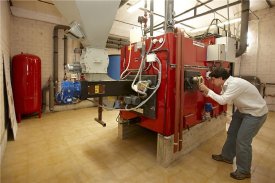Feb 2 2011
Neiker-Tecnalia (The Basque Institute for Agricultural Research and Development) has created an air-conditioned greenhouse using alternative energies that enable the reduction of energy costs, improvements in energy efficiency and an increase in crop yields. The novel system has a biomass boiler and thermodynamic solar panels, which reach an optimum temperature for the crop without using fuels derived from petroleum oil or gas.
Neiker-Tecnalia has installed a biomass boiler (using wood and other organic waste as fuel), together with thermodynamic panels, with the goal of air-conditioning greenhouses destined for intensive crop cultivation. With this method they have managed to reduce costs and improve crop yields, in such a way that seasonal products can be harvested throughout the year. This project seeks an alternative to the usual diesel or heating oil boilers, which emit significant amounts of CO2 to the atmosphere and are very costly for the farmer, given the high price of petroleum oil-derived fuels.
 Biomass boiler.
Biomass boiler.
400 kW power
The project was undertaken at a greenhouse in NEIKER-Tecnalia located in Derio, in the Basque province of Bizkaia and near Bilbao. A biomass boiler which produces 400 kW power and is, to date, the largest in Spain using air-conditioning in greenhouses was installed. With the boiler there are 40 thermodynamic panels, employed for the first time in intensive greenhouse cultivation. The combination of both energies act to heat the water which circulates in tubes located a few centimetres above the floor and below the substrate of the crop, the aim being to heat the roots.
The tubes, distributed throughout the whole surface of the greenhouse, transport water at an average temperature of 80 degrees centigrade. Thus optimum air-conditioning for greenhouses is achieved, with the result that the plants grow as in the natural production period. Achieving less expenditure in consumption and having seasonal crops all year round considerably reduces the price of the final product and, thus, enabling competition in the market with products coming from other zones.
The thermodynamic panels used generate energy thanks to the difference in temperature between a cold gas that circulates through a closed circuit and the ambient air temperature. They outstand for their low energy cost, as they are able to function in situations without sunlight and, thereby, produce energy both by day and by night. Moreover, it drastically reduces emissions of CO2 to the atmosphere. They are capable of heating water to 45 degrees centigrade and their cost per kilowatt consumed is 60 % less than the one generated by conventional diesel or heating oil boilers.
The biomass boiler used by Neiker-Tecnalia works with organic waste, such as almond nut shells, olive oil stones, tree pruning cuttings, the waste obtained from clearing forests, granulated pellets of sawdust, sawdust itself, wood shavings or any other leftover from the timber industry. The expenditure in fuel for the biomass boiler is 55 cents for kilowatt consumed, well below the 92 cents of a euro needed for boilers fed by petroleum oil-derived fuels or by natural gas or propane.
Heating the roots to reduce costs
Air-conditioning using alternative energies developed by Neiker-Tecnalia is complemented with a technique known as ‘hydroponic soil’, involving placing the plants on substrate at a height of some ten centimetres above the hard floor of the greenhouse. This method also enables the roots to be heated by pipes through which water circulates at an average temperature of 45 degrees centigrade. Directly heating the substrate where the roots are found enables reducing the ambient temperature of the greenhouse overall, thus involving less energy expenditure.
All this system involves a network of sensors (distributed throughout the greenhouse) that enables regulating the temperature of the market garden. The meters gather data in real time on the temperature and humidity of the crop zone. The data is sent to a computer which has software capable of programming different actions, such as increasing or reducing the temperature of the greenhouse or fixing the most appropriate hours for heating the plants.